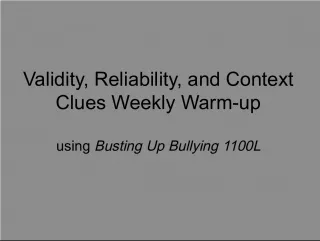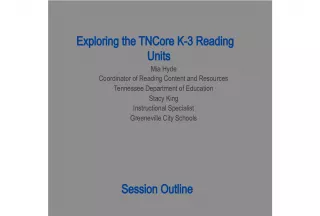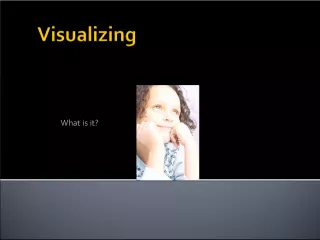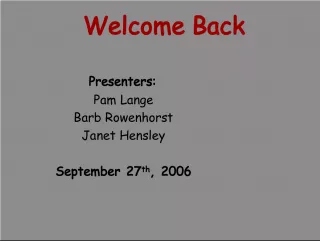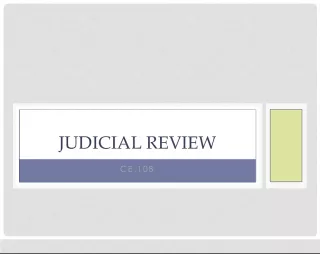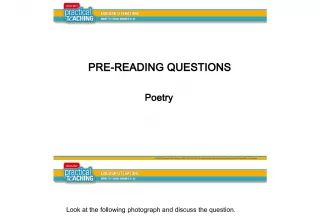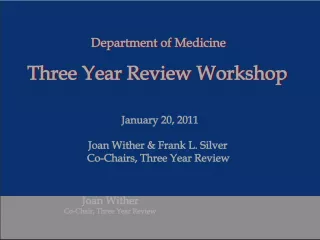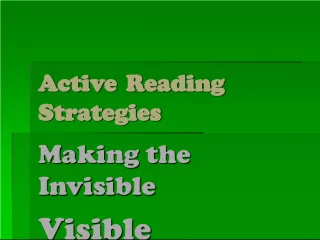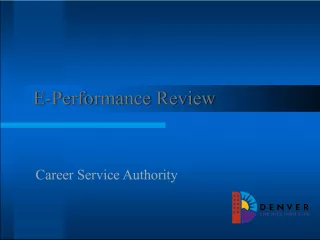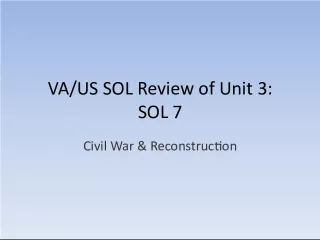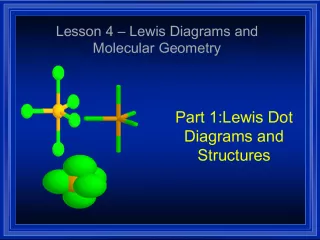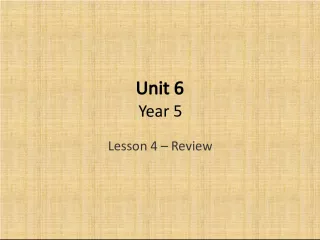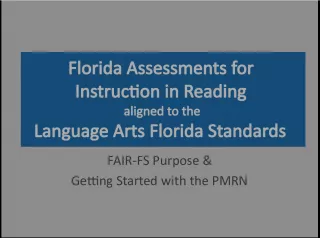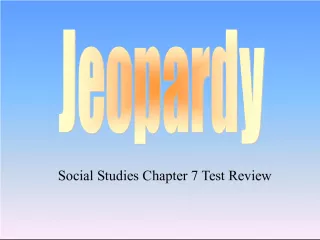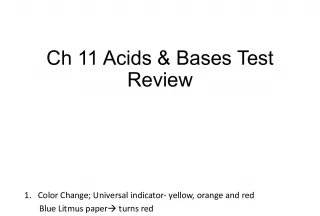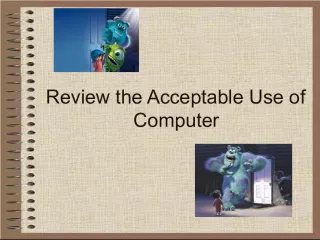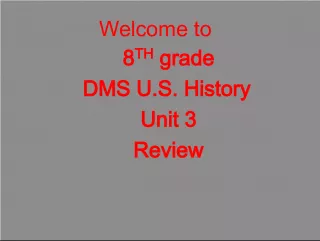Weekly Reading Review


Dispatching a weekly review of the days and times for reviews with insights on the things learned from the week's reading.
- Uploaded on | 2 Views
-
 coby
coby
About Weekly Reading Review
PowerPoint presentation about 'Weekly Reading Review'. This presentation describes the topic on Dispatching a weekly review of the days and times for reviews with insights on the things learned from the week's reading.. The key topics included in this slideshow are . Download this presentation absolutely free.
Presentation Transcript
1. Dispatch 1) When do reviews start? 2) What days of the week are the reviews? 3) Write 5 things you learned from this week’s reading? 4) When is the genetics test? 5) Complete any 7 questions from the study guide. 6) Grades are out in 2 weeks! Do you have an A+?
2. Chapter 15—Linked Genes The following is a map of four genes on a chromosome: a) Between which two genes would you expect the lowest frequency of recombination?
3. Changes in chromosome structure • deletion – loss of a chromosomal segment • duplication – repeat a segment • inversion – reverses a segment • translocation – move segment from one chromosome to another error of replication error of crossing over
4. You should know the following scientists: • --Alfred Hershey and Martha Chase • -Oswald Avery, Maclyn McCarty, and Colin MacLeod • -Erwin Chargaff • -Matthew Meselson and Franklin Stahl • Watson, Crick, and Franklin
5. DNA DNA RNA RNA Protein Protein Scientists call this the: Scientists call this the: Central Dogma of Molecular Biology! Central Dogma of Molecular Biology!
6. How do we know that all of our genetic information comes from DNA? • What type of experiment would you design to determine that DNA is the source of all genetic information?
7. Griffith’s Experiment with Pneumonia and the accidental discovery of Transformation • Frederick Griffiths was a bacteriologist studying pneumonia • He discovered two types of bacteria: – Smooth colonies – Rough colonies CONCLUSION: The smooth colonies must carry the disease!
8. Griffith’s Experiment with Pneumonia and the accidental discovery of Transformation • When heat was applied to the deadly smooth type… • And injected into a mouse… • The mouse lived!
9. • Griffith injected the heat-killed type and the non-deadly rough type of bacteria. • The bacteria “transformed” itself from the heated non-deadly type to the deadly type. Griffith’s Experiment with Pneumonia and the accidental discovery of Transformation
10. Griffith’s Experiment did not prove that DNA was responsible for transformation How would you design an experiment to prove that DNA was responsible for transformation?
11. Avery, McCarty, and MacLeod Repeated Griffith’s Experiment Oswald Avery Oswald Avery Maclyn McCarty Maclyn McCarty Colin MacLeod Colin MacLeod
12. Avery, McCarty, and MacLeod Added the non-deadly Rough Type of Bacteria to the Heat-Killed Smooth Type Carbohydrates Carbohydrates Lipids Lipids Proteins Proteins RNA RNA DNA DNA To the Heat-Killed Smooth Type, added enzymes that destroyed… To the Heat-Killed Smooth Type, added enzymes that destroyed…
13. S-Type Carbohydrates Destroyed S-Type Carbohydrates Destroyed S-Type Lipids Destroyed S-Type Lipids Destroyed S-Type Proteins Destroyed S-Type Proteins Destroyed S-Type RNA Destroyed S-Type RNA Destroyed S-Type DNA Destroyed S-Type DNA Destroyed C C o o n n c c l l u u s s i i o o n n : : D D N N A A w w a a s s t t h h e e t t r r a a n n s s f f o o r r m m i i n n g g f f a a c c t t o o r r ! !
14. The Hershey-Chase Experiment Alfred Hershey & Martha Chase worked with a bacteriophage: A virus that invades bacteria. It consists of a DNA core and a protein coat DNA DNA Protein coat Protein coat
15. Protein coats of bacteriophages labeled with Sulfur-35 Protein coats of bacteriophages labeled with Sulfur-35 DNA of bacteriophages labeled with Phosphorus-32 DNA of bacteriophages labeled with Phosphorus-32 Bacterium Bacterium Bacterium Bacterium Phage Phage Phage Phage 1. Hershey and Chase mixed the radioactively-labeled viruses with the bacteria 1. Hershey and Chase mixed the radioactively-labeled viruses with the bacteria The viruses infect the bacterial cells. The viruses infect the bacterial cells.
16. Protein coats of bacteriophages labeled with Sulfur-35 Protein coats of bacteriophages labeled with Sulfur-35 DNA of bacteriophages labeled with Phosphorus-32 DNA of bacteriophages labeled with Phosphorus-32 2. Separated the viruses from the bacteria by agitating the virus- bacteria mixture in a blender 2. Separated the viruses from the bacteria by agitating the virus- bacteria mixture in a blender
17. Protein coats of bacteriophages labeled with Sulfur-35 Protein coats of bacteriophages labeled with Sulfur-35 DNA of bacteriophages labeled with Phosphorus-32 DNA of bacteriophages labeled with Phosphorus-32 3. Centrifuged the mixture so that the bacteria would form a pellet at the bottom of the test tube 3. Centrifuged the mixture so that the bacteria would form a pellet at the bottom of the test tube 4. Measured the radioactivity in the pellet and in the liquid 4. Measured the radioactivity in the pellet and in the liquid
18. The Hershey-Chase results reinforced the Avery, McCarty, and MacLeod conclusion: DNA carries the genetic code! However, there were still important details to uncover…
19. How did DNA: 1. Store information? 2. Duplicate itself easily? These questions would be answered by discovering DNA’s structure
20. The Race to Discover DNA’s Structure
21. The Race to Discover DNA’s Structure Linus Pauling Linus Pauling 1940s 1940s Discovered the alpha- helical structure of proteins. Discovered the alpha- helical structure of proteins.
22. The Race to Discover DNA’s Structure 1950 1950 Chargaff’s Rule: Equal amounts of A denine and T hymine, and equal amounts of G uanine and C ytosine Chargaff’s Rule: Equal amounts of A denine and T hymine, and equal amounts of G uanine and C ytosine Erwin Chargaff Erwin Chargaff Why do you think the bases match up this way? Why do you think the bases match up this way? Purine + Purine = Too wide Purine + Purine = Too wide Pyrimidine + Pyrimidine = Too Narrow Pyrimidine + Pyrimidine = Too Narrow Purine + Pyrimidine = Perfect Fit from X-ray data Purine + Pyrimidine = Perfect Fit from X-ray data
23. The Race to Discover DNA’s Structure Maurice Wilkins Maurice Wilkins Rosalind Franklin Rosalind Franklin X-Ray diffraction image of DNA taken by Franklin in 1951 X-Ray diffraction image of DNA taken by Franklin in 1951
24. The Race to Discover DNA’s Structure James Watson James Watson Francis Crick Francis Crick 1953 1953 Compiled data from previous scientists to build a double-helical model of DNA Compiled data from previous scientists to build a double-helical model of DNA
25. The Race to Discover DNA’s Structure was Over • DNA is made up of: – Four nucleotides: Adenine, Thymine, Guanine and Cytosine – These follow the rules of base-pairing: • Adenine bonds with Thymine • Guanine bonds with Cytosine – A sugar-phosphate backbone • DNA is arranged in an double-helix
26. DNA Replication • The double helix did explain how DNA copies itself • We will study this process, DNA replication , in more detail
27. How does DNA replicate? Conservative Conservative Semi-Conservative Semi-Conservative Dispersive Dispersive Hypotheses:
28. 1. Bacteria cultured in medium containing a heavy isotope of Nitrogen ( 15 N) 1. Bacteria cultured in medium containing a heavy isotope of Nitrogen ( 15 N) Meselson-Stahl Experiment Meselson-Stahl Experiment
29. 2. Bacteria transferred to a medium containing elemental Nitrogen ( 14 N) 2. Bacteria transferred to a medium containing elemental Nitrogen ( 14 N) Meselson-Stahl Experiment Meselson-Stahl Experiment
30. Meselson-Stahl Experiment Meselson-Stahl Experiment 3. DNA sample centrifuged after First replication 3. DNA sample centrifuged after First replication
31. Meselson-Stahl Experiment Meselson-Stahl Experiment 4. DNA sample centrifuged after Second replication 4. DNA sample centrifuged after Second replication
32. DNA Replication The “parent” molecule has two complementary strands of DNA. The “parent” molecule has two complementary strands of DNA. Each is base paired by hydrogen bonding with its specific partner: Each is base paired by hydrogen bonding with its specific partner: A with T A with T G with C G with C
33. DNA Replication The first step in replication is the separation of the two strands. The first step in replication is the separation of the two strands.
34. DNA Replication Each parental strand now serves as a template that determines the order of the bases along a new complementary strand. Each parental strand now serves as a template that determines the order of the bases along a new complementary strand.
35. DNA Replication The nucleotides are connected to form the sugar- phosphate backbones of the new strands. The nucleotides are connected to form the sugar- phosphate backbones of the new strands. Each “daughter” DNA molecule consists of one parental strand and one new strand. Each “daughter” DNA molecule consists of one parental strand and one new strand.
36. The Race to Replicate DNA • Two teams: A and B • Individually, each team member will run to the board to add a nucleotide to the “unzipped” strand of DNA. • The first team to finish base-pairing their DNA correctly will win the game.
